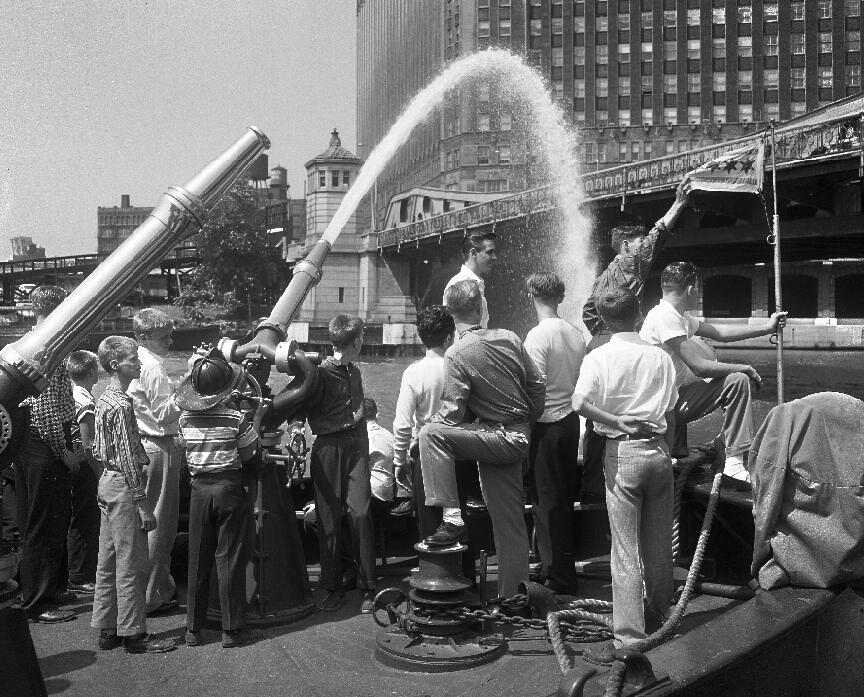
Figure 1.--Here boys from the Norwegian Lutheran Childrens Home man the hoses of the Joseph Medill Fireboat on August 9, 1959. Churches in America have played a major role in charity work. |

|
The Lutheran Church was founded in Germany and was the first Protestant Church. Luther did intend to break from the Catholic Church. He wanted to reform the Catholic Church which is why the movement is called the Reformation and not another Great Scism. It is also why the Lutheran Church is often seen as the Protestant church cloest in practice to Catholocism. Luther wanted a more personal relationship with God and downplayed the importance of the priesthood and saints. He also encouraged Bible reading. Neither did Luther name the church he helped bring about the Lutheran Church which spread throughout the Holy Roman Empire and north to the Netherlands and Scandanavia. The Church in Germany was called the Reformed or Evangelical Church, reflecting doctrinal differences among German Lutherans. The name Lutheran developed as Dutch and Swedish and finally German immigrants in America began founding churches. The Dutch and Swedes arrived first because the German states did not have large fleets and Germans did not emigrate in large numbers during the early colonial period. The first Luthgerans to reach America were the Dutch who reached Manhattan Island (1625). They founded New Amsterdam. Several churches were founded. Governor Peter Stuyvesant attempted to make the Dutch reformed Church the state religuin and supress Lutheran and other churches. Swedish colonists founded New Sweden in the Deleware River Valley to the south of the Dutch. The first Lutheran congregation we know of was founded there at Fort Christina (modern Wilmington) (1638). The Swedes built the first Lutheran church building on Tinicum Island near Wilmington (1646). The Dutch founded their first congregation (1648), The Palatinate in the German Rhineland was a major battleground of the Reformation and the 20 Years War (1618-48). It was devestated and largely depolulated. Many of the early German immigrants to America were refugees from the Palatinate who established Lutheran churches in many colonies (Delaware, Maryland, New York, and Pennsylvania). The Dutch seized New Sweden (1655) and the Englished seized New Amsterdam. The English, however, did not interfere in the religious beliefs of the people there. The Archbishop of Salzburg expelled about 20,000 Protestant farmers from the Alpine districts surronding the city (1731-32). Some of these dispossed peopled in the Salzburger migration settled in Georgia (1734). This introduced Lutheranism to the southern American colonies. Until this time, Lutheran churches in America existed as indivuidual congregations without any overall church structure. The Church began to organize on a colony (state) basis. Until the Revolutionary period, there was not a lot of interaction between the colonies. Heinrich Melchior Mühlenberg in Pennsylvania helped organize the first synod in the country (1748). America was split by the Revolutionary War, but most German and other Lutherans supported the Revolution. An additiional Lutheran synod was founded in New York (1786) as well as adjoining states. After the creation of the United States. The North Carolina Synod was founded (1803). As Americans moved west and more German and Scandinavians emigrated, Lutherans were among the imporetant grouos settling what is now referred to as the Midwest. Many small synods were formed by the Germans, Norwegians, Danes, Finns, and other national groups. This was not done on a territorial/state basis as the first synods, but often by the natiinality of the emigrants. There were some doctrinal issues, but language and ethnic familiarity were major elements in the organization of many small synods. Unlike many American churches, the Lutheran Church was not split by the Civil War because there was n national organization. The first national organization was the Evangelical Lutheran Synodical Conference of North America (1872).
Even so, by the turn-of-the 20th century, there were about 150 different Lutheran bodies in America that were not afliliated with the Evangelical Conference. Many of these small indeoendent Lutheran synods and other bodies merged into the United Lutheran Church of America (1918). We suspect the pressure on German Americans during World War I was a factor here. The Lutheran Church–Missouri Synod was also part of the Evangelical Conference, but now is the second most important American Lutheran group. The American Lutheran Church (1961) and the the Lutheran Church in America (1962) joined to become the Evangelical Lutheran Church in America (1988) is now the largest American Lutheran organization. While almost all Lutherans belong to one of these bodies, there are still a small number of non-affliated Lutgeran churches. Canadian Lutherans also belong to the major American Lutheran bodies. Many Lutherans but not the more conservative Missouri Synod in recent years have pusued an ecumenical spirit with other major Protestant denominations. The Evangelical Lutheran's Churchwide Assembly decided (1997) on a full communion with the Presbyterian Church (USA), the United Church of Christ, and the Reformed Church in America. It reached a similar agreement with churches closer to Catholic practices, the Episcopal Church and the Moravian Church (1999).
Navigate the Boys' Historical Clothing Web Site:
[Return to theMain American Protestant page]
[Return to the Main U.S. religion page]
[Return to the Main religion country page]
[Introduction]
[Activities]
[Biographies]
[Chronology]
[Clothing styles]
[Countries]
[Bibliographies]
[Contributions]
[FAQs]
[Glossary]
[Images]
[Links]
[Registration]
[Tools]
[Boys' Clothing Home]
